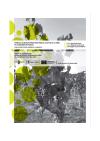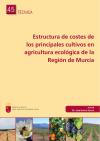Media library
Documentary, graphic and/or audiovisual knowledge objects are offered here, offering information on various sectors and topics. Use the keyword search or search filters to access current audiovisual and documentary knowledge objects useful for your implementation.
If you have any questions or suggestions, please contact us here.

Cost structure of the agricultural production guidelines of the Region of Murcia: nuts, pome fruit, vines, and olives
Publication dedicated to the most characteristic woody crops of rural Murcia, including nuts, pome fruit, table and wine grapes, and olive trees.

Manual of good practices for vine cultivation in the region of Murcia. Socioeconomic and environmental assessment
The manual aims to convey, in a direct and simple way, to winegrowers and technicians involved in the regional wine chain, sustainable cultivation guidelines, both for dryland bush-fed vines and for irrigated trellis vines.

Cost structure of the main crops in organic farming in the Region of Murcia
Document describing the main guidelines for regional organic farming in Murcia

How to assess the quality of your soil. Visual soil assessment in olive groves
Guide that guides allows to estimate the visual evaluation of the soil (EVS) through a quick and simple method to estimate the condition of the soil, the suitability, quality and limitations that a soil presents for the olive grove
Procedure for uprooting olive plantations for ornamental purposes in the Autonomous Community of Aragon
Information on the uprooting of olive tree plantations for ornamental purposes in the Autonomous Community of Aragon
Information note and management recommendations: thrips damage to citrus, persimmon, and pomegranate.
Given the damage caused by thrips observed since May on leaves and fruit in various citrus, persimmon and pomegranate crops and the confirmation of the presence of Scirtothrips aurantii Faure in certain areas, the following recommendations have been considered appropriate:
Recommendations for the strategy to control leaf necrosis in persimmons
During the 2019 campaign, control failures were detected in some plots in the Ribera Alta region (Alzira, Benimuslem, Guadassuar, and Massalavés). Systematic surveys carried out in 2020 revealed that the resistance of the fungus Plurivorosphaerella nawae to the QoI group of fungicides (strobilurins) was present in most persimmon-producing areas in the province of Valencia.
Olive fly (Bactrocera oleae) treatment notice
The olive fruit fly population is beginning to increase this year, so an initial bait treatment is recommended. Once the first pitted olives appear, the next generation of adults will emerge approximately 25 days later, and a second bait treatment is required to control them.
Monitoring the olive fruit fly (Bactrocera oleae)
Field Pest Situation Report, 2024 Campaign, Week 43: October 21-October 27
Scirtothrips aurantii, information note and management recommendations, damage caused by thrips in citrus, persimmon and pomegranate.
Given the damage caused by thrips observed since May on leaves and fruit in various citrus, persimmon and pomegranate crops and the confirmation of the presence of Scirtothrips aurantii Faure in certain areas, the following recommendations have been considered appropriate:
Phytosanitary bulletin of notices and information
Pollinating insects are vitally important for the proper functioning of crops. Pollination is essential to ensuring the quantity and quality of crops and food production, directly linking wild ecosystems with agricultural production systems.
“Xylella fastidiosa Conference.” Diseases caused by Xylella fastidiosa and its status worldwide.
On February 12, 2019, a "Seminar on Xylella fastidiosa" was held in the Assembly Hall of the Ministry of Agriculture, Fisheries, and Food. This seminar is part of the measures adopted by the Ministry to disseminate information and raise awareness about the fight against and control of Xylella fastidiosa.
Poster on Xylella fastidiosa in the Balearic Islands
Xylella fastidiosa (Wells et al.) is a quarantine phytopathogenic bacterium that has a very wide range of host plants (more than 300 plant species), and can cause serious damage to the most important crops of the Balearic Islands, such as almond, vine, olive, citrus or fig trees, and to numerous species of ornamental plants (rosemary, lavender, polygala and acacia, among others).
Program of actions to transpose the National Contingency Plan for Xylella fastidiosa in the Autonomous Community of Extremadura
Xylella fastidiosa is a bacterium that causes rapid and widespread decline in plants. In the most severe cases, the leaves and branches may dry up and, ultimately, the entire plant may die. In many host species, the presence of the bacteria does not produce any symptoms, making detection extremely difficult. X.
Triptych Rhynchophorus ferrugineus (Red palm weevil)
Recommendations for treatments against red palm weevil and other palm borer pests
Paysandisia archon Triptych, recommendations against the palm borer caterpillar
Paysandisia archon, a lepidopteran of the Castniidae family, is native to South America, whose larvae feed on palm trees. The first detection in Europe was in France and Italy in 1998-99. In Spain, it was first detected in Catalonia in May 2002, and in the Valencian Community in June of that same year.
Monitoring Scirtothrips aurantii on citrus, pomegranate and persimmon.
Scirtothrips aurantii is a pest that affects various crops such as pomegranates, persimmons, citrus fruits, and table grapes. This pest was first detected in Spain in 2020, in the province of Huelva.
Monitoring Pseudococcus longispinus in Persimmon
Cottony mildew is one of the pests that most concerns the persimmon production sector in the Valencian Community. They feed on the plant's sap, weakening it, and excrete large amounts of honeydew, on which saprophytic fungi develop, forming a characteristic black felt known as "sour patch." Fruits stained with sooty mold lose commercial quality.
Monitoring Paraleyrodes minei in Persimmon
Whiteflies are among the pests of greatest concern to the persimmon production sector in the Valencian Community. Within this group of insects, the species most commonly found on persimmons are Dialeurodes citri, Paraleyrodes minei, and Aleurothrixus floccosus.




